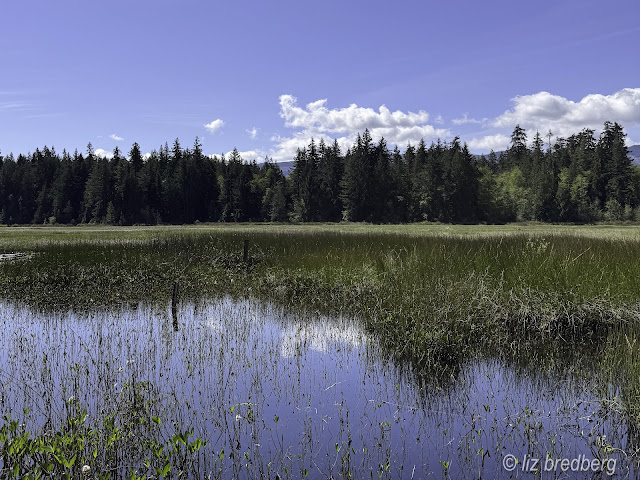May 4th and 11th
In addition to the seasonal changes within the Forest and Wetlands, there have been some new, human-associated developments, somewhat mysterious in their origin.
Culturally modified cedars have been present for many years, but in the past week, some new bark-stripping has occured.
Three small cedars near the entrance of the Forest now show signs of stripping. On consulting a Qualicum knowledge keeper who visited the area recently, it is not likely that this is the work of someone who is aware of how best to gather bark--the trees are shaded, and rather small to be a good source of bark. That said, she reassured me that they are unlikely to be damaged by this harvest. Notwithstanding, I hope that the bark stripping will not be widespread in the area. Although the land is unceded to the Qualicum Nation, I'm not sure how the Mosaic Forest Management company, who nominally have the care of the area, would regard this practice.
In addition to this modification, the new path now has bridges over small streams and boggy areas.
It's apparent that someone who cares deeply for the Forest and Wetlands is working quietly and working well at its maintenance. Like the changes in the flora and fauna, this is interesting and pleasing to watch.
Meanwhile, spring is well underway.
Skunk cabbage is flourishing, although yet to come into bloom
Huckleberry is starting to form fruit.
Last autumn, the one Sitka mountain ash in the area was crushed in a blowdown. It is now regenerating with several smaller trees starting to form.
Summer oyster mushrooms are putting in early appearances on tree trunks.
I'll never cease to marvel at the diversity that a tree can host--moss, fungi, and lichen all can be nourished in a small area. And of course that's not including insects, small mammals, and birds who make their homes in trees.
Once a tree is down, its role as host to the life in the forest is not ended. This fallen log hosts a glorious variety of mosses.
The Marsh is greening up wonderfully.
The water level is starting to sink as the snowpack on the Beaufort Range diminishes.
Arrowsmith keeps its watch over the Marsh and Forest.
In this season, the Marsh chimes with red-winged blackbirds.
11 May
Despite intermittent rainshowers, the Forest and Wetlands welcomed me this morning with its quiet beauty. The advance of spring growth is enchanting, and as an uncommon gift, apart from birds and squirrels, I had the place to myself.
Yesterday was the annual Hamilton Marsh Tour Day. The surrounding community is invited to visit and explore the area, guided by a number of us who visit regularly and are familiar with its biodiversity. It's a good event, and an important one. People pay their first visit, and many become advocates for the area's preservation.
There are often intakes of breath from first-time visitors when we reach the Marsh, with its vista of Mount Arrowsmith, its fringe of transitional growth, and the lush green of the spring vegetation. It was a fine day, even if, at its close, those of us introducing the area to visitors found ourselves exhausted.
But today, the Forest and Marsh were no less beautiful despite the absence of visitors. Somehow I felt a need to return to the area when it was quieter. I felt grateful and humbled to be granted exclusive time there.
At the Forest's entrance, a stand of Saskatoon blossoms bids us welcome.
Every spring, they draw the attention of visitors to Mid-Island forests. They seem to abound this year, and are often described as two (or more) species. In fact, the "pink trillium" is actually a matured white trillium, sending its message to pollinators that its time for visits is at an end. The plant is now generating new growth, and needs no further attention.
Perhaps interestingly, other flowering growth also shows this "senescence." Candyflower, or the blossoms of Siberian miner's lettuce, also shifts from white to pink.
I have observed a stand of these flowers, both white and pink, where bees visited the white flowers exclusively. It seems possible that the same dynamic exists with other white flowering plants as with the trillium.
I learned a new phrase during the guided walk in the Forest before our visitors arrived: "squirrel midden." I had known of shell middens, and I'd observed evidence of Douglas squirrel feasting on Douglas fir in the area, but always referred to it as "remains of squirrel parties."
evidence of their little feasts, "squirrel middens," is present throughout the Forest.
It appears that another mammal, larger, but also hungry after long winter naps, is seeking food as well.
At the fringe of the Marsh, the flowers of the twinberry are making way for pairs of berries.
In the Marsh, buckbean is in bloom.
The past dry month has brought the water level down, but as I sat on the dock with a sandwich and a thermos, a light rain began to fall. I had brought a large plastic bag in my backpack to protect my camera and binoculars. I covered them, and continued with my lunch, enjoying the sounds and scents that the shower offered.
Two deer, infrequent visitors to the Marsh, studied me, then grazed the sedges.
The light shower intensified to a steady downpour. I packed the remnants of my lunch and made my way through the Forest's shelter to my truck, grateful for today's fine visit, and hopeful that yesterday's visitors will join in advocating for the area's preservation.
















.jpg)












Comments
Post a Comment